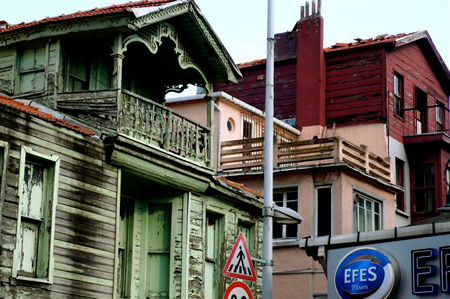
On the Bosporus, the historic waterway where Europe meets Asia.
FILLMORE ABROAD | Dan Max
For 20 years I’ve been making regular trips to Turkey from my flat above Fillmore Street. During a month-long visit to Istanbul this summer, I experienced a perfect afternoon when I met up with Berk Kinalilar, the owner of the neighborhood’s Troya restaurant and a native Turk.
Troya, at 2125 Fillmore, has become well known in the year it has been open for successfully creating the authentic and refined flavors of Turkish cuisine. People are loving it, and I’ve become a regular. Before my trip last year, Berk gave me a list of restaurants to try in Istanbul. This year, it turned out he was going home to see his mother and father while I was there. He suggested we get together.
When I called him from my hotel, Berk announced that his father, Engin, had invited us to join him for lunch, but that it would require a bit of traveling. I knew that would add some extra excitement.
We left my hotel in the Taksim district in a taxi and drove to the ferry landing in Besiktas. Soon we were aboard a ferry headed north on the Bosporus, the historic waterway that separates Europe and Asia. It would be a 50-minute ride to Sariyer, our destination and Berk’s hometown.
All ferry rides on the Bosporus are magical, and this trip was no exception. On a perfect sunny afternoon, the shorelines of Europe and Asia were clear and easily viewed. The ferry made a momentary stop at Kanlica on the Asian side before proceeding under two bridges toward Bebek on the European side.
We took in the sights — especially the rows of charming wooden konaks, the prized remnants of domestic architecture from the Ottoman period. While many of the konaks have been restored, many sit like ghosts, still awaiting their turn. Each one is different in scale and ambition. Some are elaborate, especially those along the Bosporus. Others are simple. But all demonstrate the artistry and refined skills of an earlier era.
Rumeli fortress occupies the shoreline hill at Bebek. It’s a massive stone structure, complete with ramparts and high thick walls wonderfully preserved. It was built in 1452 by Sultan Mehmed II, who would soon end Byzantine rule and establish the Ottoman Empire.

Rumeli fortress, on the shoreline hill at Bebek, was built in 1452.
Arriving in Sariyer, a city of 280,000 inhabitants noted for its fleet of fishing boats that go daily to the Black Sea, we walked to Berk’s father’s home. He drove us several miles north of town to Gelisli, a seafood restaurant situated on a bluff above the Bosporus. No one could design a restaurant such as this. It is the creative outgrowth of a long cultural heritage.
From our table, we watched ocean-going ships navigating the final channel before entering the Black Sea, headed to ports in Russia. Several plates of appetizers were served, and then the main act: a long platter holding a large sea bass that most likely had been a resident of the Black Sea earlier in the day. The fish reclined majestically even after we cut into it. It was prepared simply and tasted as good as it could get.
When we finished lunch, Berk’s father suggested we drive to the point where the Bosporus flows into the Black Sea. Dessert would come later.
There are no monuments and no official reminders of the historic significance of this site, only a small fishing village with a breakwater. In the water is a cluster of boulders. I like to imagine they were there from antiquity as a witness to the human migrations that for thousands of years have passed by. If only those rocks could talk.
Returning to Sariyer to catch the ferry, it was now time for the dessert. Turkey excels in the art of making pastry, as it does in everything culinary. The local specialty was dondurmali, which consists of shredded chicken breast blended in custard. Doesn’t sound good? It is, though — very good. The ferry arrived and returned us to Istanbul after a perfect afternoon.
I’m back on Fillmore Street now, basking in the afterglow of another trip to Turkey, with its fabulous culture and a stream of history that remains intact. I’ve never been there in the springtime. Maybe next year.

Rows of wooden konaks are prized remnants of Ottoman domestic architecture.
Filed under: Locals





